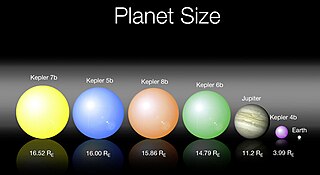Top Qs
Timeline
Chat
Perspective
Kepler-7
G-type star located in the constellation Lyra From Wikipedia, the free encyclopedia
Remove ads
Kepler-7 is a star located in the constellation Lyra in the field of view of the Kepler Mission, a NASA operation in search of Earth-like planets. It is home to the fourth of the first five planets that Kepler discovered; this planet, a Jupiter-size gas giant named Kepler-7b, is as light as styrofoam.[7] The star itself is more massive than the Sun, and is nearly twice the Sun's radius. It is also slightly metal-rich, a major factor in the formation of planetary systems. Kepler-7's planet was presented on January 4, 2010 at a meeting of the American Astronomical Society.
Remove ads
Nomenclature and discovery
Kepler-7 received its name because it was the home to the seventh planetary system discovered by the NASA-led Kepler Mission, a project aimed at detecting terrestrial planets that transit, or pass in front of, their host stars as seen from Earth.[8] The planet orbiting Kepler-7 was the fourth planet to be discovered by the Kepler spacecraft; the first three planets combed from Kepler's data had been previously discovered, and were used to verify the accuracy of Kepler's measurements.[9] Kepler-7b was announced to the public on January 4, 2010 at the 215th meeting of the American Astronomical Society in Washington, D.C. along with Kepler-4b, Kepler-5b, Kepler-6b, and Kepler-8b. Kepler-7b was noted for its unusually and extremely low density.[7]
The planet's initial discovery by Kepler was verified by additional observations made at observatories in Hawaii, Texas, Arizona, California, and the Canary Islands.[10]
Remove ads
Characteristics
Kepler-7 is a sunlike star that is 1.347 Msun and 1.843 Rsun. This means that the star is about 35% more massive and 84% wider than the Sun. The star is estimated to be 3.5 (± 1) billion years old. It is also estimated to have a metallicity of [Fe/H] = 0.11 (± 0.03), meaning that Kepler-7 is approximately 30% more metal-rich than the Sun; metallicity plays a significant role in the formation of planetary systems, as metal-rich stars tend to be more likely to have planets in orbit.[11] The star's effective temperature is 5933 (± 44) K.[12] In comparison, the 4.6 billion-year-old Sun[13] releases less heat, with an effective temperature of 5778 K.[14]

The star has a visual apparent magnitude of 13,[3] meaning that it is extremely dim as seen from Earth. It cannot be seen with the naked eye.[9] It is estimated to lie at approximately 3160 light years from the Solar System.[2]
There is a star that is 4 magnitudes dimmer located 1.90 arcseconds away, whether this a gravitationally bound companion star or a chance optical alignment is unknown.[15]
Remove ads
Planetary system

Kepler-7b is the only planet that has been discovered in Kepler-7's orbit. It is 0.433 MJ and 1.478 RJ, meaning it is 43% the mass of planet Jupiter, but is nearly three halves its size. With a density of 0.166 g/cm3,[9] the planet is approximately 17% the density of water at room temperature. This is comparable to styrofoam.[7] At a distance of 0.06224 AU from its host star, Kepler-7b completes an orbit around Kepler-7 every 4.8855 days.[9] Planet Mercury, for comparison, orbits the Sun at 0.3871 AU, and takes approximately 87.97 days to complete one orbit.[16] Kepler-7b's eccentricity is assumed to be 0, which would give Kepler-7b a circular orbit by definition.[9]
See also
References
External links
Wikiwand - on
Seamless Wikipedia browsing. On steroids.
Remove ads

